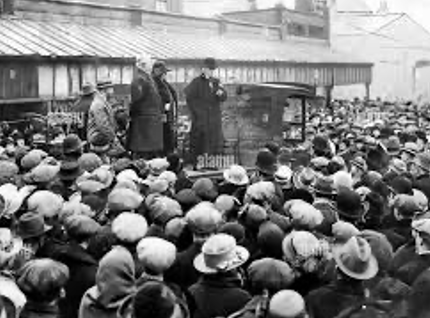The General Election of 1924

Professor Russell Deacon, Chair of the Lloyd George Society, marks the centenary of the 1924 General Election.
Unlike the general election of 2024 the one a century again saw the Liberals lose both a substantial number of seats and their chances of leading a government again. The October 1924 General Election in the United Kingdom was held on 29 October 1924. This election was significant as it followed a period of political instability and was crucial for the major parties, particularly the Labour Party and the Liberal Party.
The Liberal Party was lead by Lloyd George and he campaigned in various regions, including constituencies in Wales, where he had a strong personal following. He also travelled to key urban areas, such as London, to rally support and engage with potential voters. His speeches emphasized the need for unity and progress, although he struggled to regain the trust of voters who had turned to the Labour Party.
In the lead-up to the October 1924 General Election, David Lloyd George had high expectations for the Liberal Party, believing they could regain some of their former influence. He envisioned the Liberals as a viable alternative to the Labour and Conservative parties, leveraging his reputation and achievements from the wartime coalition government. He aimed to position the party as the party of progress and social reform, particularly in the areas of housing and welfare, as the economic situation in Britain continued to deteriorate.
Campaign Strategy
The Liberals and Lloyd George campaigned on several key issues:
- Social Reforms: They emphasized their commitment to improving living conditions and welfare, which resonated with working-class voters and those affected by the post-war economic challenges.
- Rebuilding the Economy: They aimed to highlight their plans for economic recovery, advocating for government intervention to support industry and employment.
- Coalition Politics: Lloyd George attempted to present the Liberal Party as a stabilizing force that could bridge the gap between the Conservatives and Labour, although this narrative was met with scepticism.
Reasons for Poor Performance
Despite these efforts, the Liberal Party performed poorly in the 1924 election, winning only 40 seats and approximately 20.2% of the vote. Several factors contributed to this disappointing outcome:
- Declining Popularity: The party was still reeling from the effects of its previous coalition government and the perception of internal disunity, which alienated many voters. The previous election’s disappointing performance and the fallout from their coalition with the Conservatives had damaged their credibility (Pugh, 2010; McKibbin, 1998).
- Rise of the Labour Party: The Labour Party’s popularity surged as they effectively mobilized working-class support and presented themselves as the true representatives of social reform. Many former Liberal supporters shifted their allegiance to Labour, perceiving it as a more genuine advocate for workers’ rights (Harris, 1998).
- Intra-Party Conflicts: The Liberal Party faced significant internal divisions, with various factions struggling for control and direction. This lack of unity hindered their ability to present a cohesive message to voters (Lloyd George, 1933).
- Changing Political Landscape: The political landscape in Britain was shifting, with voters increasingly polarized between Labour and the Conservatives. The Liberals were unable to effectively navigate this change and lost their position as the dominant third party (Pugh, 2010).
- Failure to Connect: Lloyd George’s campaign did not resonate with many voters who were more concerned with immediate economic issues than grand visions of social reform. The electorate was weary of promises that seemed distant from their day-to-day realities (McKibbin, 1998).
In summary, while Lloyd George entered the 1924 General Election with expectations of reviving the Liberal Party’s fortunes, a combination of external pressures and internal struggles led to a significant electoral setback, demonstrating the challenges faced by a party in decline although the party continued to be a relevant force in Welsh politics for the next 30 years (Deacon, 2014)
Individual Results
- David Lloyd George:
- Constituency: Caernarvon Boroughs
- Result: Won
- Votes: 8,427 (approximately 49.6%)
- Second Place: Labour candidate David John Williams with 7,162 votes
- Majority: 1,265 votes
- Gwilym Lloyd George:
- Constituency: Pembrokeshire
- Result: Won
- Votes: 10,023 (approximately 51.9%)
- Second Place: Conservative candidate W. T. Edwards with 9,116 votes
- Majority: 907 votes
References
- Deacon, R (2014) The Welsh Liberals, Cardiff, Welsh Academic Press
- Harris, R. (1998). The Labour Party: A Short History. London: Blackwell.
- Lloyd George, D. (1933). The Truth about the Peace Treaties. London: Victor Gollancz Ltd.
- McKibbin, R. (1998). Parties and People: England 1914–1918. London: Penguin Books.
- Pugh, M. (2010). The Making of Modern British Politics 1867–1939. Oxford: Wiley-Blackwell.
For more detailed information about the election and its context, you can refer to these sources:
- The National Archives provides insights into the political landscape of the time and the implications of the election results. National Archives
- BBC History offers a concise overview of British elections, including significant events like the 1924 election. BBC History
UK Parliament details the historical context and outcomes of general elections. UK Parliament.
